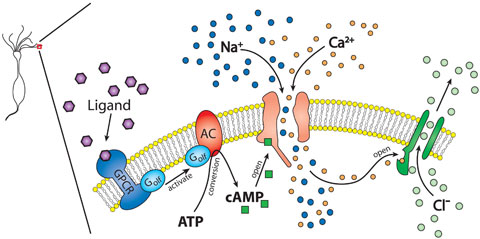G-protein-coupled receptors
The G-protein coupled receptors (GPCRs), also termed as seven-transmembrane domain receptors, or 7TM receptors, or heptahelical receptors, and G protein-linked receptors (GPLR), comprises a large protein family of receptors which sense molecules outside the cell and activate inside signal transduction pathways and, finally, cellular responses. They are known as transmembrane receptors as they pass through the cell membrane, and they are known as seven-transmembrane receptors as they pass through the cell membrane seven times.
The G-protein-coupled receptors are only found in eukaryotes, involving choanoflagellates, yeast, and animals. The ligands which bind and activate such receptors involve light-sensitive odors, hormones, compounds, pheromones, and neurotransmitters, and differ in size from minute molecules to peptides to large proteins. The G protein-coupled receptors are included in most diseases, and are also the aim of approximately 40% of all modern medicinal drugs.
It also involves receptors for slow neurotransmitters, most of the hormones, and sensory transduction molecules significant in vision, smell, and taste.
The iconic feature of these receptors is the seven membrane-spanning segments (MI to MVII) which are as shown in figure. The GPCRs bind small molecules (like amines, glutamate) and a wide range of peptides. The metabotropic glutamate receptors have small homology with the others. The third cytoplasmic loop between MV and MVI couples to G proteins which are vital for the signal transduction.

Figure: G-protein-coupled receptors: diagram showing transmembrane segments and ligand binding sites.